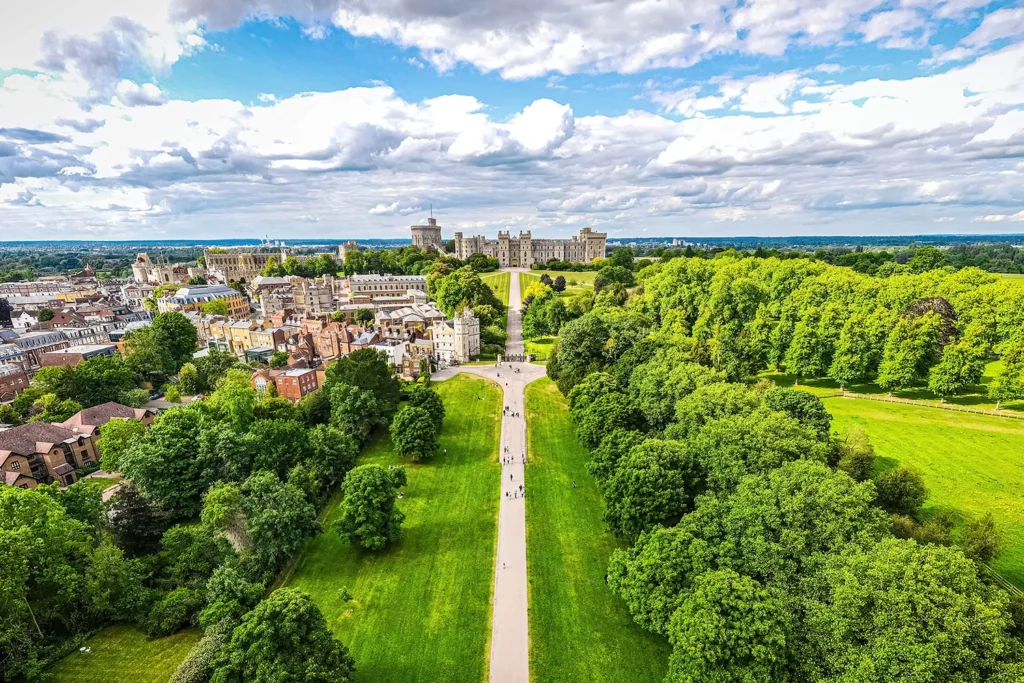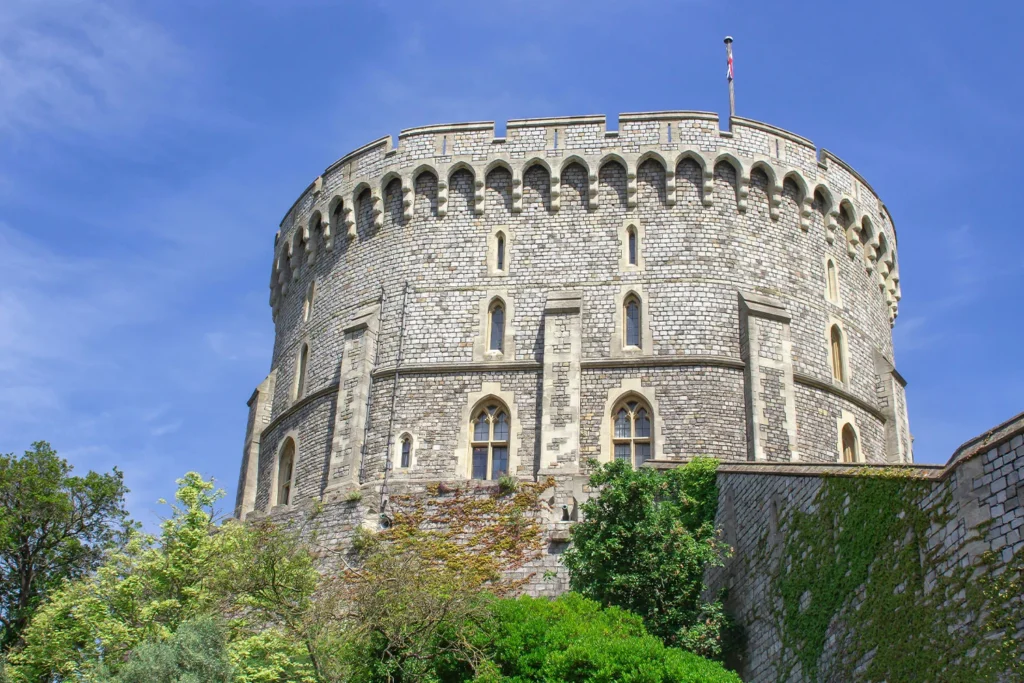When it comes to the British royal residence, Buckingham Palace immediately comes to mind. However, it is not the only estate at the Windsors’ disposal. Here is the remarkable residence that lent its name to the reigning royal family of the United Kingdom.
Windsor Castle is unique not only due to its fame—it’s the largest inhabited castle in the world! It is also the main attraction in the town of Windsor, located in Berkshire County, about 35 km from central London. This exceptional palace has been the residence of the British royal family for over 1,000 years and is the origin of the name of the ruling British royal family, the Windsors. Curious about how modern-day kings live? You’ll find the answer at this castle.
History of Windsor Castle
Windsor Castle in its present form is the result of nearly a thousand years of development. It was built between 1070 and 1086 by order of William the Conqueror, the then-king of England. The fortress was intended to be part of a defensive chain of castles built around London. However, its location and, above all, its proximity to both the modern capital and hunting grounds made Windsor Castle not only ideal as a fortress but also as a royal residence. This idea was quickly implemented, and by 1110, Henry I, William’s son, had his royal apartment there.
The following centuries of Windsor Castle as a royal residence were marked by expansions and modifications to the building. The structure was gradually enhanced, its character adapted to prevailing trends, and additional apartments, rooms, and even a chapel were added. The artistic development of the castle was largely influenced by Charles I, who, as an art enthusiast, began amassing an extraordinary collection of works that continue to adorn the palace halls to this day.
The castle’s peaceful history came to an end in the 17th century with the outbreak of the English Civil War. The occupied fortress became the headquarters of parliamentary forces and simultaneously a prison for captured royalists until the war’s conclusion. Charles II returned to the throne in 1660, bringing back Windsor Castle’s splendor. However, the castle’s golden era was the Victorian age, when it served as the main residence of the royal family and was even opened to private guests.
The royal residence in the face of disaster
The end of the 20th century was not kind to Windsor Castle. In 1992, a fire broke out in Queen Victoria’s private chapel, destroying a large portion of the residence. Imagine the scale of the tragedy, considering it took the fire services 15 hours to extinguish the flames!

It’s still hard to believe that only two works of art were destroyed in the fire. The rest had been moved, purely by chance, to rooms located in the wing that remained intact. The restoration work took five years, but by 1997 the castle was reopened to the public.
The current function of Windsor Castle
Today, the royal residence is not only a witness to British history and one of the most frequently visited sites near London. The palace continues to host official state events, ceremonies, and visits from foreign dignitaries and heads of state. Members of the royal family often spend their weekends there as well.
Another significant site for modern history is St. George’s Chapel, where Prince Harry and Meghan Markle were married in 2018 and where Queen Elizabeth II was laid to rest. Interestingly, this is also the chapel where the Order of the Garter is still bestowed today, following medieval ceremony traditions.
Due to the fact that the residence is still actively used by the reigning royal family, not all parts of the castle are open to tourists, though a significant portion is accessible. The number of rooms and apartments available for tours may vary throughout the year, depending on the royal family’s schedule and commitments. How can you tell if the reigning monarch is present at the residence? Simply look at the Round Tower, which is adorned with the Royal Standard whenever the crowned head is in residence.
GOOD TO KNOW: The kitchen at Windsor Castle is the oldest working kitchen in all of England. Since the time of Edward III, chefs have served meals there to 32 monarchs, including, of course, Queen Elizabeth II.
Windsor Castle in numbers
A few numbers can help illustrate the true scale of this famous castle. The largest inhabited castle in the world, visited by over a million guests annually eager to uncover royal secrets, is 800 meters long and has an area of 45,000 m². It has been home to 40 monarchs, each leaving their mark on the residence. The grounds of Windsor Castle include over 1,000 rooms, the largest of which is St. George’s Hall. Measuring more than 55 meters in length and 9 meters in width, it can accommodate up to 162 guests. The fortress includes 19 towers, and the main entrance is reached via a 2.65-mile (4 km) long avenue.
Palace interiors
Entering the royal palace is a unique opportunity to see how royal families live in modern times. A walk through the castle’s rooms allows visitors to immerse themselves in the history not only of the building but also of the entire country.

Inside the castle, you will see the state apartments, Queen Victoria’s children’s rooms, numerous halls filled with world-renowned paintings, and the famous chapel. Which elements of the palace deserve particular attention?
State Apartments
One of the main attractions during a visit to Windsor Castle are the state apartments, which can only be toured in the absence of the royal family. These rooms undoubtedly impress with the opulence of their decorated furniture, ceilings, and the vast array of artistic craftsmanship, including priceless works of art by such renowned artists as Holbein, Van Dyck, and Rubens. Visitors can admire the collections displayed in St. George’s Hall, the Grand Reception Room (formerly a ballroom), and the impressive Waterloo Chamber.
St. George’s Chapel
This chapel is considered one of the finest examples of Gothic architecture in all of England. During your visit, be sure to look up to appreciate the intricate stone ceiling, and explore the nave to find the beautiful marble monument dedicated to Princess Charlotte.
Although the wealth and splendor of the chapel are undeniable, they are not its greatest treasure. Beneath St. George’s Chapel lie the royal tombs. Eleven monarchs, including Queen Elizabeth II, George VI, Henry VIII, and Charles I, are buried there.
Royal Dollhouse
Among Windsor Castle’s treasures is a work of art unlike the others: Queen Mary’s Dollhouse, built between 1921 and 1924, and it is the most famous and largest of its kind in the world. More than 1,500 of the 20th century’s finest artists and craftsmen contributed to its current appearance. It’s a miniature residence that any real royal couple would be proud to live in. Each room in the dollhouse was furnished with remarkable attention to detail.
You’ll find a beautiful royal sitting room and dining room, a library with miniature versions of original works by renowned authors of the time, a perfectly tuned piano, a garden, and even a fully stocked wine cellar. The dollhouse is equipped with electricity, running water, and functioning elevators. It’s hard to believe, but no detail was overlooked.
The Round Tower
Among the 19 towers defending the castle, one easily stands out from the rest. Windsor Castle’s Round Tower has served as the castle’s central defense since its construction in the 12th century. Over the centuries, the tower has played various roles in the palace’s life.

It was used as a prison, a military equipment storage facility, and a place for royal ceremonies, but for most of its time, the Round Tower served as a vantage point, offering a panoramic view of the surrounding area necessary for monitoring potential threats and protecting the castle from attack. Today, it is primarily used to store the Royal Archives, and its terrace is appreciated by castle visitors seeking beautiful landscapes.
Windsor Castle as a Prison
Not only the Round Tower served as a prison in the past. Hundreds of prisoners of war, including officers of the royal armies and members of the loyal nobility, were held in the castle’s dungeons, towers, and other rooms. Many were imprisoned for months, even years, during which they managed to carve their names and family crests into the prison walls. Some traces of their captivity have survived to this day. In a room located above one of the gates, the signatures left by prisoners can still be seen.
FUN FACT: The most prominent prisoner ever held at Windsor Castle was undoubtedly King Charles I. He was imprisoned in a cell for several days in 1647, and after his execution, his body was buried in St. George’s Chapel.
Visiting the Castle
When planning a visit to Windsor Castle, it’s important to keep a few key points in mind to make the experience smoother. Tickets are best purchased in advance (you can find them on this site, for example). Online reservations not only guarantee ticket availability but also offer the chance to buy them at a slightly lower price. The ticket price includes an audio guide, which will take you through the castle’s long history and highlight the key points of the tour.
While this method of exploring the castle doesn’t guarantee answers to all your burning questions, it’s an excellent option for leisurely uncovering the secrets of royal life, while also finding time for a visit to the café or some luxury souvenir shopping at the on-site stores.
Practical information
- It is best to purchase tickets for Windsor Castle in advance. This way, you can avoid standing in long lines and reduce the risk of tickets being sold out.
- Address: Windsor SL4 1NJ, United Kingdom
- Buy tickets on GetYourGuide